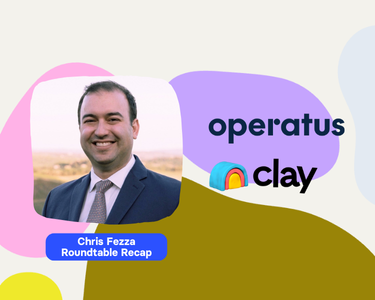


September 25, 2025
What We Learned at Sculpt 2025
Sculpt is Clay’s community conference for GTM builders. This year, we joined as an official Clay partner, which for us meant rolling up our sleeves, hosting two roundtables, and swapping real-world lessons with folks who live in GTM ops, sales, and growth every day.
Both sessions generated incredible insights, and we’re excited to share some of the highlights here.
Session 1: Enterprise AI Adoption: Scaling Personal Wins to Organizational Impact
AI has quickly moved from experimentation to expectation, and many GTM teams are figuring out how to go from individual “aha moments” to true organizational transformation. This session surfaced both opportunities and roadblocks that leaders are facing today.
Key takeaways:
Personal adoption isn’t enough: Many leaders shared that while AI is being adopted by individuals within an organization, scaling those wins requires structure, leadership buy-in, and governance around its usage. Success comes from formalizing processes, creating frameworks for adoption, and building enablement programs that bring scattered “shadow AI” practices into unified, compliant workflows.
Shadow AI refers to employees adopting and using AI tools independently, outside of any official company process, policy, or governance.
Measure beyond time saved: By now, we all know that AI can free up capacity. Who cares if you can do more calls if they aren’t converting? When rolling out an AI program, it’s important to measure beyond just time savings to prove effectiveness. For example, unlocking niche data via Clay generates a higher-converting pipeline, not just more activity.
Customer Success teams are a great place to start introducing AI to your organization: An easy starting AI use case in your org could be to have your CSMs use AI to gauge call sentiment and layer it with product usage signals to spot healthy vs. at-risk accounts. With enablement from Growth/RevOps teams for templates, data access, and simple workflows, you can standardize it and roll it out across the entire CS org.
Session 2: GTM Data Management: Architecting a System That Scales
With today’s proliferation of tools, data management has become one of the thorniest challenges for GTM teams. This roundtable dove deep into how leaders are building architectures that actually scale.
Key takeaways:
Data sprawl is real but solvable: Most companies are juggling 5–6 enrichment sources, with uneven coverage depending on their ICP. Clay stood out for its ability to surface harder-to-find SMB and brick-and-mortar data, filling critical gaps in the ecosystem.
“Golden records” are foundational: Whether managed in Salesforce, Snowflake, or elsewhere, organizations stressed the need for clearly defined ownership of “source of truth” data. Without this, downstream automation and reporting quickly break.
PLG + SLG requires thoughtful architecture: Leaders shared that mapping account hierarchies, workspaces, and usage data correctly is essential. The most effective strategies kept product usage data in warehouses until users hit key thresholds, ensuring CRMs stayed clean while still empowering sales to act at the right time.
Conclusion
Sculpt reminded us why small-group conversations matter: you get straight talk, practical examples, and ideas you can try Monday. For our part, we’re taking these insights back into how we help teams build cleaner data foundations and smarter GTM workflows with Clay.
If you joined one of our roundtables, thank you! If not, we’d love to compare notes on your AI or data architecture journey. Reach out to us for a chat.





